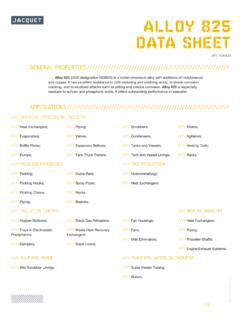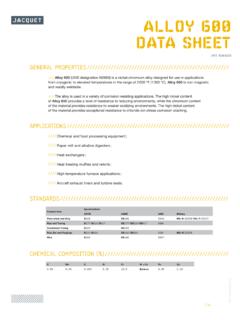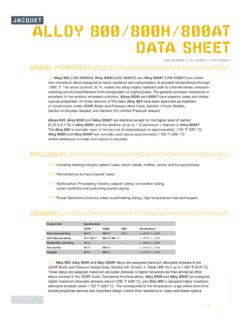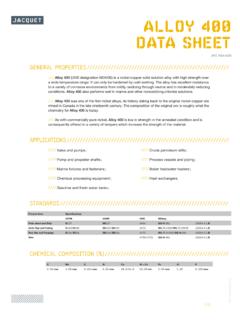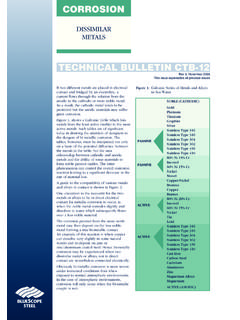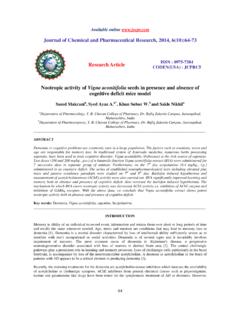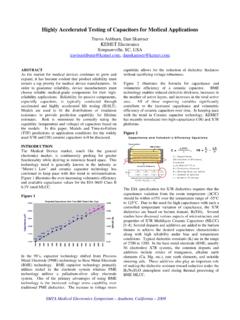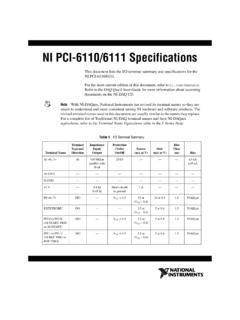Transcription of ALLOY 200 201 DATA SHEET - Jacquet Metal Service
1 1 / 8 For internal use 200 / 201 data SHEETUNS N02200 / UNS N02201//// ALLOY 200 (UNS designation N02200) and ALLOY 201 (UNS designation N02201) are wrought commercially pure nickel. The alloys differ only in the maximum carbon level allowed by specification, % maximum for ALLOY 200 and % maximum for ALLOY 201. Both alloys provide highly ductile mechanical properties over a wide temperature range. Both alloys provide corrosion resistance in neutral to moderately reducing environments. In the annealed condition, either ALLOY possesses the approximate strength of mild steel. As-rolled material is sometimes furnished to provide higher strength ALLOY 200 and ALLOY 201 provide high thermal and electrical conductivity in comparison to nickel base alloys , stainless steels and low ALLOY steels.
2 The alloys are Because long-time exposures of ALLOY 200 in the 800 to 1 200 F (427-649 C) range result in precipitation of a carbon phase and loss of ductility, it is not recommended for Service above 600 F (316 C). For applications above 600 F (316 C), the low carbon ALLOY 201 should be For proposed Service temperatures approaching 800 F (427 C), resistance to creep should be considered as a design Food production;//// Fluroine generation;//// Storing and transportation of phenol;//// Manufacture and handling of sodium hydroxide;//// Production of hydrochloric acid and chlorination of hydro-carbons such as benzene, methane and ethane;//// Manufacture of vinyl choloride monomer;//// Heat exchangers;//// Tube sheets;//// Piping;//// Shell plate;//// Tank heads;//// Tanks;//// Storage vessels;//// Mixers.
3 //// PROPERTIES //////////////////////////////////////// //////////////APPLICATIONS //////////////////////////////////////// ////////////////////////// INdUSTRIES//// FAbRICATIONS2 / 8 For internal use //////////////////////////////////////// ////////////////////////Product formSpecificationsASTMASMEAMSDINVdT VUKP late SHEET and StripB162SB1625553 (N02201 only)177503453072 Rod and BarB160SB160-177523453076 Smls Pipe and tubindB161 / B163SB161 / SB163-177513453074 TemperatureYield Strength % OffsetElongation F CpsiMPapsiMPa% in 2"682021 50014867 000462472009321 00014566 5004584640020420 20013966 5004584460031620 20013966 20045647 TemperatureYield Strength % OffsetElongation F CpsiMPapsiMPa% in 2"682015 00010358 500403502009315 00010356 1003874540020414 80010254 0003724460031614 3009852 5003624280042713 5009341 20028458Ch EmICAL CO mPOSITION (%)
4 //////////////////////////////////////// ///////mEC hANICAL PROPERTIES //////////////////////////////////////// ///////AlloyCMnSSiCuNi+ max//// The following tables illustrate the short time room and elevated temperature tensile properties of annealed ALLOY 200 and ALLOY 201. The tables indicate that ALLOY 200 is stronger than ALLOY 201 in the annealed condition. Specifications generally recognize this difference by assigning lower minimum yield and tensile strength values to ALLOY 201 than to ALLOY ShORT TImE TENSILE PROPERTIES AS A FUNCTION OF TEmPERATURE//// ALLOY 200//// ALLOY 2013 / 8 For internal use StrengthYield Strength % OffsetElongationHardnessksiMPaksiMPa% in 2"Birnell (3 000 kg)
5 Rockwell BRod and BarHot Fin60-85415-58515-45105-31055-3590-15045 -80 Cold drawn65-110450-76040-100275-69035-10140- 23075-98CD or HR Ann55-75380-52015-30105-21055-4090-12045 -70 PlateHot Rolled55-100380-69020-80140-55055-35100- 15055-80HR Ann55-80380-55015-40105-27560-4090-14045 -75 SheetCold Rolled90-115620-79570-105480-72515-2-90 minCR Ann55-75380-52015-30105-21055-40-70 maxTubeStress Rel65-110450-76040-90275-62035-15-75-98 Annealed55-75380-52012-3085-21060-40-70 maxCondenser TubeAnnealed55-75380-52015-30105-21060-4 0-65 maxStress Rel65-110450-76040-90275-62035-20-75-98 FormTensile StrengthYield Strength % OffsetElongationHardnessksiMPaksiMPa% in 2"Birnell (3 000 kg)Rockwell BRod and BarHF, HF Ann50-60345-41510-2570-17060-4075-100-Co ld drawn60-100415-69035-90240-62035-10125-2 00-CD Ann50-60345-41610-2570-17060-4075-100-Pl ateHot Rolled50-70345-48512-3583-24060-35--HR Ann50-70345-48512-3583-24060-40--Tube, PipeCD Ann50-70345-48510-2870-19560-40-62 maxStress Rel60-105415-72530-85205-58535-15-75-98/ /// The tensile properties of both ALLOY 200 and ALLOY 201 can be significantly enhanced by cold working.
6 In plate products, this can be achieved by control of the finishing temperature in hot rolling and the elimination of the anneal that follows hot rolling. SHEET and strip can be cold rolled to higher strength. The typical range of enhancement of room temperature properties is shown in the next table. These properties depend on the thermomechanical history and section size and cannot be developed in all gages//// TyPICAL PROPERTy RANGES IN COLd wORkEd ALLOY 200//// TyPICAL PROPERTy RANGES IN COLd wORkEd ALLOY 200//// ThE EFFECTS OF COLd wORkING4 / 8 For internal use As measured by Charpy impact tests, ALLOY 200 is one of the toughest metals. Both hot rolled and annealed samples have higher impact strength than cold-worked ImPACT STRENGTh//// ImPACT PROPERTIES FOR ALLOY 200 ConditionHardness Birnell (3 000 kg)Charpy-VCharpy TorsionCharpy TensionFt-lbJft-lbJTwist Ft-lbJElong.
7 In in. ( mm), %Reduction of area (%)Hot Drawn-24 % reduction, Drawn-Annealed at 1 350 F (732 C) / 3 StrengthYield Strength % OffsetElongationReductionHardness F CksiMPaksiMPa% in 2" of Area (%)Rockwell CHot TyPICAL PROPERTy RANGES IN COLd wORkEd ALLOY 200 Phy SICAL PROPERTIES //////////////////////////////////////// /////////////DensityMagnetic PermeabilitySpecific lb / in3 Ferromagnetic Btu / lb- g / cm3 Saturation Magnetization App. 6 400 Gauss456 J / kg- KSpecific GravityMelting F = 2615-2635 C = 1435-14465 / 8 For internal use mAL PROPERTIES //////////////////////////////////////// //////////////TemperatureSpecific HeatThermal ConductivityElectrical ResistivityModulus of ElasticityCoefficientAlloy 200 ALLOY 201of Thermal Expansion C FJ / kg KBtu / lb FW / m KBtu in.
8 / ft h FW / m KBtu in. / ft h F cm circ mil / ftkN / mm 103 ksi10-6 / K10-6 / 0001 / 8 For internal use RESISTANCE////////////////////////////// /////////////////////Test EnvironmentTemperatureCorrosion RateNameMedia & Concentration F CmpyAcetic Acid5 % CH3CO2H w/ air702140 Acetic Acid10 % Acid56 % CH3CO2H1768066 Acetic Acid85 % CH3CO2H w/ air7021400 Acetic Acid98 % CH3CO2H24111612 Caustic Soda50 % Soda50 % Soda75 % NaOH2501201 Formic Acid (liquid)90 % CH2O270214 Formic Acid (vapor)90 % CH2O270217 Hydrochloric Acid1 % HCI214101680 Hydrochloric Acid10 % HCI863080 Hydrochloric Acid10 % HCI2211058 000 Nitric Acid10 % H3PO421610212 000 Phosphoric Acid10 % Acid10 % H3PO4214101154 Phosphoric Acid40 % H3PO475241 Sodium Hypochlorite500 ppm Acid2 % H2SO470212 Sulfuric Acid5 % H2SO41406010 Sulfuric Acid5 % H2SO4 w/ air863061 Sulfuric Acid19 % H2SO4223106110 Sulfuric Acid20 % H2SO470214 Sulfuric Acid50 % H2SO4 w/ air863016 Sulfuric Acid50 % H2SO42551241 000 Sulfuric Acid96 % H2SO4 w/ air863010//// ALLOY 200 and ALLOY 201 are used primarily in reducing or neutral environments.
9 The alloys may also be used in oxidizing environments that cause the formation of a passive oxide Examples of environments in which ALLOY 200 and ALLOY 201 have been used are caustics, high temperature halogens and salts other than oxidizing halides. They are also used in the food processing The nickel content of these alloys renders them virtually immune to chloride stress corrosion cracking. The alloys have been used in fresh and many other process waters with superior ALLOY 200 and ALLOY 201 have been used in caustic solutions such as those encountered in the production of caustic soda when chlorate level is low. Nickel is not susceptible to caustic stress corrosion cracking. When chlorate is about %, as in diaphragm cell technology used in caustic soda production, an iron chromium ALLOY might be Sulfurous atmospheres are corrosive to nickel alloys , especially above 600 F (316 C).
10 Oxidizing mineral acids and oxidizing salts are also AqUEOUS CORROSION dATA7 / 8 For internal use TREATmENT //////////////////////////////////////// ///////////////////FORmAbILITy //////////////////////////////////////// ////////////////////////// Considerable latitude exists in heat treating temperatures for ALLOY 200 and ALLOY 201. Temperatures in the range of 1 300 F (704 C) to 1 700 F (927 C) may be employed. Car or box anneal cycles which employ long furnace times should use the lower temperatures. Continuous anneal cycles which employ short times should use higher temperatures. If heavy forming is required, anneal time may be increased to provide fully soft material. //// Sulfur, phosphorus, lead, zinc and other low-melting metals are potential contaminants which must be avoided.
